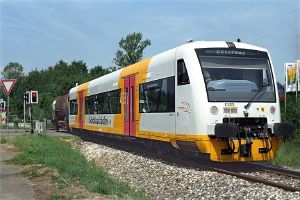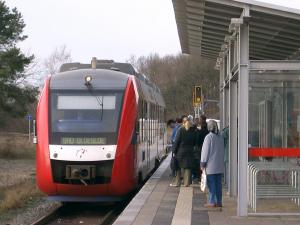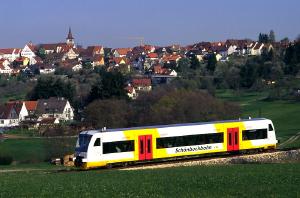Bringing back rail transit to small town areas
Setting up an existing freight line for 60 mph passenger traffic is currently done at the cost figure of newbuilt 217 mph doubletrack in Spain. Due to this cost level, small-scale rail transit does not exist in the USA.
If ridership expectations have to be scaled down, costs have to be scaled down as well. If this is done successfully, subsidy for the passenger mile doesn't have to look worse than in many big projects with big trains. Examples for reactivation at such stripped-down standard are given here. They have been taken from Germany, a country with high labour costs and a wealth of environmental regulations, where such projects should be as expensive as in the USA.
Example 1: The Schönbuchbahn
The Schönbuchbahn, a branch line near Stuttgart, connects Dettenhausen (5200 inhabitants) to the mainline station within Böblingen (46400 inhabitants). There are two small towns along the way. Basic traffic concept is a halfhourly memory schedule with DMUs, using two trains. Triple traction is used for traffic peaks, evening service is provided with a single unit.
| Line closed for passenger traffic | 1966 |
| Line reopened for passenger traffic | 1996 |
| Line length | 10.4 miles |
| Intermediate stations | 10 |
| Average stop distance | 0.95 mile |
| Line speed | 50 mph |
| Travel time | 24 minutes |
| Average speed | 26 mph |
| Existing bus traffic | 2000 passenger boardings / workday |
| Expected rail traffic | 2500 passenger boardings / workday |
| Achieved rail traffic | > 6000 passenger boardings / workday |
| Investment for infrastructure rebuilding | 22 million € |
| Investment into infrastructure, per mile | 2.1 million € |
| Owner of infrastructure | Zweckverband Schönbuchbahn (the local counties) |
| Operator's investment into trains | million € |
| Public investment into trains | million € |
| Vehicles | 6x Stadler Regioshuttle |
| Operator | Württembergische Eisenbahngesellschaft (Connex) |
| Train pairs on workdays, saturdays, sundays | 37, 26, 15 |
| Subsidy for operation, per train mile | 5.80 € |

A "freight train" on the Schönbuchbahn
Off peak, a surplus DMU is sometimes used to deliver wagonloads to industry along the line. This option comes at a price: For pulling freight cars, the DMUs have to use the disfunctional 19th century link coupler, which is still standard for freight in Western Europe. Some other operations use the same type of DMU with fully automated couplers.
Example 2: The Ammertalbahn

Before the line was rebuilt, some miles of the Ammertalbahn have looked like this.
The Ammertalbahn, a secondary line near Stuttgart, connects the mainline station at Herrenberg (30900 inhabitants) to the mainline station in Tübingen (84000 inhabitants). Several settlements of 1000 - 3700 inhabitants are stopped at along the way. Basic traffic concept is a halfhourly memory schedule with DMUs. The majority of trains are operated in double traction, evening trains with a single car. At school begin time, quadrupling is necessary.
| Line closed for passenger traffic | 1966 |
| Line reopened for passenger traffic | 1999 |
| Line length | 13.3 miles |
| Intermediate stations | 8 |
| Average stop distance | 1.5 miles |
| Line speed | 62 mph |
| Travel time | 24 minutes |
| Average speed | 33 mph |
| Expected rail traffic | Lower, but not directly comparable |
| Achieved rail traffic | 6150 passenger boardings / workday |
| Investment for infrastructure rebuilding | 18 million € |
| Investment into infrastructure, per mile | 1.35 million € |
| Owner of infrastructure | Zweckverband Ammertalbahn (the local counties) |
| Operator's investment into trains | ~5.9 million € |
| Public investment into trains | ~5.9 million € |
| Vehicles | 8 - 9x Stadler Regioshuttle |
| Operator | Deutsche Bahn AG |
| Train pairs on workdays, saturdays, sundays | 39, 28, 20 |
| Subsidy for operation + infrastructure maintenance / year | 2.230.000 € |
| Same, per train mile | 6.93 € |
After reactivation, daily passenger boarding count on workdays was slightly above 5000. Integrated ticketing, which does not only integrate the buses in the Ammer Valley, but also the local citybus systems at the endpoints, has gained hundreds of additional passengers. If the passenger can ride the whole public transport journey on one ticket, the transport system is more successful.
Example 3: Neumünster Süd - Bad Segeberg
This secondary track connects Bad Segeberg (16 000 inhabitants) to the mainline at Neumünster (80 000 inhabitants), and stops at some small settlements. It is one part of the line from Neumünster to Bad Oldesloe (23 500 inhabitants), which is located at another mainline. Reason for line closure has been, that the main traffic flow in this area is directed towards downtown Hamburg, but this railroad line does not point into this direction. It might be usable as a freight bypass of the big city, but this orientation generates little passenger traffic.

"2 DMUs" is the complete roster of the railroad company "NBE nordbahn". One of them arrives at Rickling (3300 inhabitants),
the most important intermediate stop.
Basic traffic concept is an hourly memory schedule with DMUs. Instead of coupling peak hour units, the operator uses bigger articulated DMUs with about 130 seats, which travel back and forth between Neumünster and Bad Oldesloe, the complete line, from morning to evening. If a reserve unit is needed, the operator gets one on loan from another nearby operation.
| Line closed for passenger traffic | 1984 |
| Line reopened for passenger traffic | 2002 |
| Line length | 16.7 miles |
| Intermediate stations | 4 |
| Average stop distance | 3.3 miles |
| Line speed | 75 mph |
| Travel time | 20.5 minutes |
| Average speed | 48.9 mph |
| Expected rail traffic | 1200 passenger boardings / workday |
| Achieved rail traffic | > 2000 passenger boardings / workday |
| Investment into infrastructure, incl. public investment | 18.75 million € |
| Public investment into infrastructure | 14.58 million € |
| Investment into infrastructure, per mile | 1.12 million € |
| Owner and operator of infrastructure | Deutsche Bahn AG |
| Public investment into trains | none |
| Operator's investment into trains | 3.6 - 4 million € ??? |
| Vehicles | 2x Alstom Coradia LINT 41 |
| Train operator | NBE nordbahn Eisenbahngesellschaft (50% AKN, 50% HHA) |
| Train pairs on workdays, saturdays, sundays | 20, 20, 21 |
| Operating subsidy per train mile | approx. 7 € |
With a top speed similar to BART, and a stop distance similar to their express trains, these DMUs achieve the same or a slightly better average speed in a rural environment.
